How Will the Counterexample Continue to Generate Infinite Truth Trees
Truth Tree Test of Validity: An Example
Let's return one more time to this argument:
(P ~Q)
~Q)
(Q R)
R)
(~R P)
P)
 Q
Q
We showed that this argument is valid, by two different methods: truth tables, and then through the indirect strategy. Now we've built an improved and streamlined version of the indirect strategy, the truth trees; so let's test this argument one more time, with this new method.
When we use truth trees to see if an argument is valid, we start the same way we did in the indirect test: to see if the argument is valid, assume the opposite – that is, assume that the argument is invalid. And 'assuming the argument is invalid' amounts to assuming that there's a Validity Counterexample – a possible situation where all the premises are true, but the conclusion is false.
In our new truth tree notation – where left-of-the-line means True, and right-of-the-line means false – a Validity Counterexample would look like this:
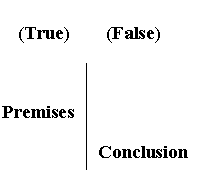
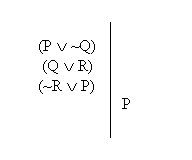
And then, just like we did in the original Indirect Test, we follow through all the consequences of this assumption, guided by our semantic rules – which have now also been transformed into truth tree notation.
Let's begin with the first premise, "(P ~Q)". This is a disjunction; and we know that it's a true disjunction, because it's on the left of the line. Now, all true disjunctions follow the same rule in truth trees: the True Disjunction rule.
~Q)". This is a disjunction; and we know that it's a true disjunction, because it's on the left of the line. Now, all true disjunctions follow the same rule in truth trees: the True Disjunction rule.
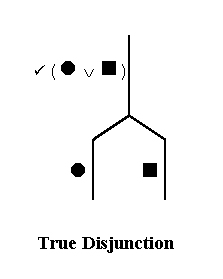
This rule just tells us what the semantic rules always tell us about disjunctions: if the whole disjunction is true, then either the left part is true, or the right part is true (possibly both).
So we break up the first premise, "(P ~Q)", into its two parts "P" and "~Q", following the true disjunction rule.
~Q)", into its two parts "P" and "~Q", following the true disjunction rule.
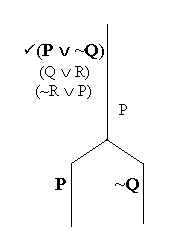
And we can follow up on this, by breaking down the right part, "~Q", as well. "~Q" is a negation; and since it's on the left side of its little line (that right branch), we know it's a true negation. And all true negations follow exactly the same semantic rule – which is, of course, the True Negation rule.
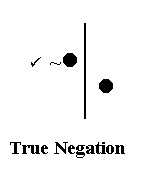
This rule says what the semantic rules say about every negation: if the whole negation is true, then the thing negated is false.
So if "~Q" is true, then "Q" itself must be false.
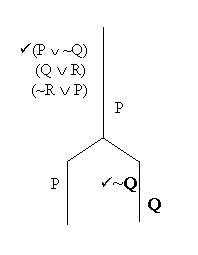
Now that we've broken the first premise down to sentence letters, we need to diagnose each of the two paths, to see if each one of them is really possible. For each path, we start at the bottom, and trace upward to the top of a tree, the way an air bubble would move up through pipes filled with water.
Start with the left path, with "P" at the bottom, and release the bubble. This is the path it would trace upward.
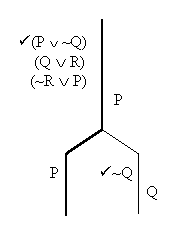
We only need to look at the sentence letters on this path to decide if it's a possible situation. An impossible situation will be one which violates the Principle of Bivalence – a situation where some sentence is both true and false at the same time; and in truth trees, this will always pan out in some sentence letter being true and false at the same time.
So we trace our way up the left path, looking only at the sentence letters.
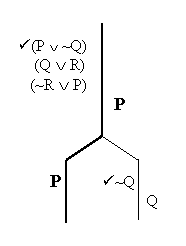
In this path, we find that "P" is on the left (it's true), and also on the right (it's false). But that's impossible: the Principle of Bivalence says that no sentence can be both true and false at the same time. So this path is impossible. So we close it off, and don't waste any more time on it: we're looking for a possible situation where the premises are true and the conclusion false, not an impossible one.
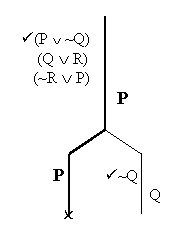
The right path has two sentence letters: a "Q" on the right (false "Q"), and "P" on the left (false "P").
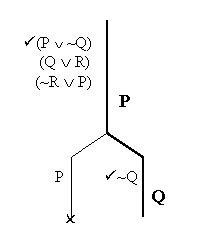
But having both "P" and "Q" false doesn't violate Bivalence. So this right path stays open.
Next we break down the second premise, "(Q R)". Since this is another true disjunction, just like the first premise, we break it down in the same way, using the True Disjunction rule.
R)". Since this is another true disjunction, just like the first premise, we break it down in the same way, using the True Disjunction rule.

So "(Q R)" branches, with "Q" on the left of one path, and "R" on the left of the other.
R)" branches, with "Q" on the left of one path, and "R" on the left of the other.
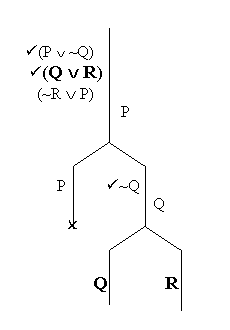
Now we need to diagnose each of these two paths for possibility, so we don't waste time on dead-end impossible situations.
Following up the left path, from bottom to top like a bubble, we find a "Q" on the left (true "Q"), a "Q" on the right (false "Q"), and a "P" on the right (false "P")
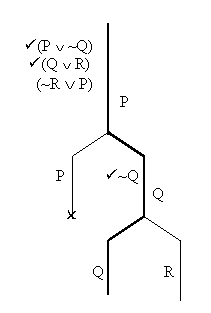
But this is a situation where "Q" is true and false at the same time; and that's a violation of Bivalence. So we close this path.
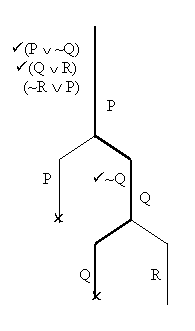
Next we diagnose the other path. Following it from bottom to top like a bubble, and looking only at the sentence letters, we find an "R" on the left (true "R"), a "Q" on the right (false "Q"), and a "P" on the right (false "P"). A situation where "P" and "Q" are false, and "R" is true, is no violation of Bivalence. This situation is really possible. So we leave this path open.
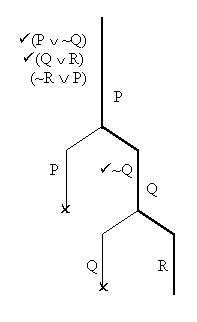
We still have one last premise to break down into sentence letters. And this premise,
"(~R P)", is on the left. Another true disjunction, calling for one more use of the True Disjunction rule.
P)", is on the left. Another true disjunction, calling for one more use of the True Disjunction rule.

Following this rule, the sentence "(~R P)" will branch, with the left part, "~R", to the left of one line, and the other part, "P", to the left of the other.
P)" will branch, with the left part, "~R", to the left of one line, and the other part, "P", to the left of the other.
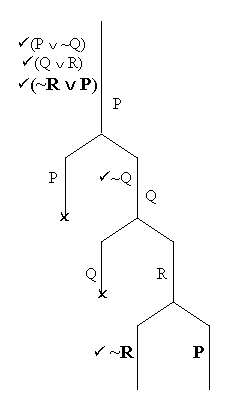
And "~R" can be broken down in turn. Since "~R" is on the left, it's a true negation; so we break it down using the True Negation rule.

Since "~R" is true, "R" must be false.
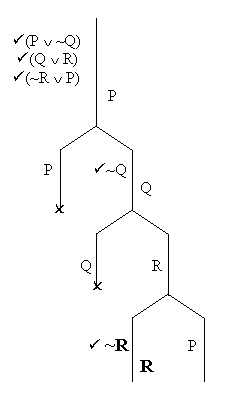
Now we just need to diagnose these two paths, and our truth tree will be finished.
Following the left path up from bottom to top, we find an "R" on the right (false "R"), an "R" on the left (true "R"), a "Q" on the right (false "Q"), and a "P" on the right.
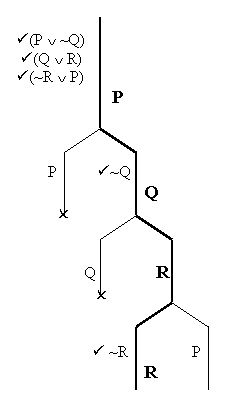
But since this is a situation where "R" is both true and false, Bivalence says this situation is impossible. So we close off this path.
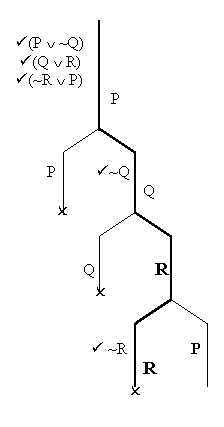
The remaining path has "P" on the left ("P" is true), "R" on the left ("R" is true), "Q" is on the right ("Q" is false), and "P" is on the left ("P" is false).
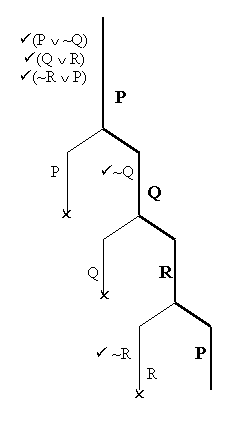
And since this amounts to a situation where "P" is both true and false, Bivalence says that this situation is impossible. So we close of this last path as well.
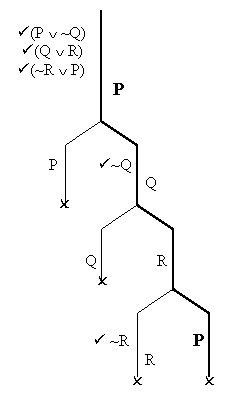
So what happened here? We started by assuming that this argument is invalid. But no matter which way we tried to work it, that assumption blew up in our face, violating the
Principle of Bivalence by having a sentence true and false at the same time. So it turns out that the original assumption – that the argument is invalid – must be wrong. So the argument is valid.
That's what a valid argument will look like in a truth tree: after breaking everything
bigger than a sentence letter down to sentence letters (by using the tree version of our
semantic rules), every path will close.
On the other hand, if even one path stays open right to the very end, that would show that the original assumption – that the argument is invalid – really is correct. In a case like that, we'd be looking at an invalid argument.
Source: https://www.ux1.eiu.edu/~bbeakley/class/1900old/formal/ch2/prob5tree/prob5tree.htm
0 Response to "How Will the Counterexample Continue to Generate Infinite Truth Trees"
Post a Comment